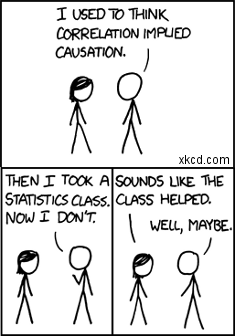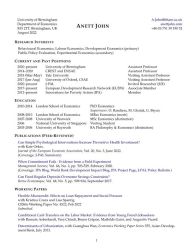
Anett John
Assistant Professor (with tenure)
Department of Economics, University of Birmingham
Affiliate, CREST and ENSAE Paris
IPA, JPAL, EUDN, IZA Research Fellow
Senior M & E Specialist, C4ED
PhD 2014, London School of Economics

Areas of Interest
-
Policy Analysis and Evaluation
References
-
Prof. Bruno Crépon
Prof. David Laibson
Prof. Imran Rasul
Prof. Marie-Claire Villeval
Policy references on request
Contact
-
University of Birmingham
Economics Department
University House
Birmingham, B15 2TY
United Kingdom
E-mail: A.John@bham.ac.uk
Research and Policy

Fieldwork team for my Commitment Savings project - September 2012, Philippines
I have 12 years of experience in policy analysis and
evaluation, with a focus on causal impact evaluation
methods. A large part of my work since 2012 involved the
planning, implementation and evaluation of large-scale
randomized control trials (RCTs) in France, Morocco, the
Philippines, Kenya, and the United Arab Emirates. Running
an RCT involves many stages, including the conceptual
design of a policy intervention, the recruitment and
training of field staff on the ground, the implementation
under real-world conditions while staying true to the
research methodology, the design of large-scale household
surveys, and the subsequent analysis of data using a
variety of quantitative (and sometimes qualitative)
methods. In addition to experimental methods, I am
experienced with quasi-experimental identification
strategies including RDD, Diff-in-Diff, IV, and Matching.
Once an analysis is complete, the results are disseminated
widely to both policymaker audiences and the scientific
community. Crucially, evaluation projects rely on a close
cooperation with institutional partners. Past and present
institutional partners include the French Public
Employment Service, vocational training providers in
Morocco, health providers in Kenya, several microfinance
organizations in the Philippines, and educational
providers in the UAE.
A key interest which connects many of my projects is why
people so often fail to make profitable investments –
choices with costs in the present and benefits in the
future – even when standard economic barriers
(information, credit constraints, access) are minimal or
absent. Applications range across many areas of life, and
around the world – from financial decisions to investments
in one's health, human capital, employment path, or
business. A strong past focus of my work has been the
impact of time preferences and self-control on
individuals' lives. More recently, I am studying the
importance of social and emotional skills for economic
decisionmaking.
Ongoing Policy Research Projects
Abstract
Despite potentially high gains in terms of labour market outcomes, the demand for vocational training programs remains low in France, in particular for young and low-educated people. Since the 2008 economic crisis, the French government implemented numerous campaigns to provide and finance high-quality training places, inform jobseekers, and motivate them to participate. Despite these efforts, the entry rate into training programs for jobseekers has been consistently around 10% since 2010. In cooperation with the French Public Employment Service (France Travail), we developed light-touch, scalable interventions to directly address the barriers to training enrollment. In a first step, we administered a survey to 20,048 jobseekers to comprehensively study the barriers preventing individuals from taking up vocational training. We distinguish between "external" (neoclassical) barriers and “internal" (psychological) barriers. External barriers relate to obstacles originating from the jobseekers’ environment (information, supply, and financing of trainings), while internal (or psychological) barriers relate to obstacles jobseekers face due to their preferences, beliefs, or cognitive constraints (Babcock et al 2012). The key emerging finding is the importance of beliefs: Jobseekers view the direct costs of training as the biggest external obstacle to take-up, but they simultaneously hold pessimistic beliefs about the availability of funding. In addition, we find evidence that jobseekers may be constrained by their beliefs about themselves, and in particular about their ability to achieve desirable outcomes and overcome obstacles. Such beliefs are referred to as “self-efficacy” in the psychology literature (Bandura 1977), and have recently gained traction in economics (McKelway 2020, John and Orkin 2021, Ghosal et al. 2020). Interventions targeting jobseekers’ beliefs may be easier and cheaper to implement than large-scale policy interventions targeting the supply or financing of trainings. We designed and currently test four interventions aimed at changing jobseekers’ beliefs, using different versions of a training support app. A grant has been obtained from the French Ministry of Labor (DARES) to finance the project.
Abstract
Youth participation in programs designed to enhance their employability is usually low. This paper reports the results from a large randomized experiment in which young, unskilled jobseekers in France receive a monthly cash transfer for a two-year period totaling up to €4,800, conditional on their participation in the French national career guidance program. Cash transfers lead to a significant increase in program participation (which mainly entails meetings with counselors), and sharply reduced drop-out rates. As a result, there is a large increase in the job offers, vocational training and career building workshops proposed to the young jobseekers. However, the jobseekers' response to these increased opportunities for employability investment is a precisely estimated zero. Moreover, we observe a significant reduction in employment over the first six months and only a minor increase in income. The results point to a strong impact of financial incentives, but also to the need to design more sophisticated incentive schemes if the goal is to improve employability investments.
Building Skills that Matter: Demand-driven job training and on-the-job support
Abstract
The productivity of Moroccan firms is among the lowest across the MENA region and has declined since 2000 (World Bank, 2018). One key challenge is a misalignment between the skills taught in local educational institutions and the needs of the labor market. Sectors including informationand communications technology (ICT), tourism, and banking are growing fast, but struggle to findcandidates with the required technical, behavioral and linguistic competencies (Agénor et al. 2015). At the same time, Moroccan youths with tertiary education are five times more likely to be unemployed than those without any formal education (HCP 2017). One of the leading explanations is that there is a mismatch between the skills acquired and those demanded by fast growing sectors. More than 70 percent of Moroccan recruiters report difficulties finding qualified candidates that have the necessary technical or linguistic skills. In addition, many among the unemployed lack the necessary soft skills due to lack of work experience and other factors.
In cooperation with Education For
Employment-Morocco (EFE-Maroc), we experimentally
evaluate whether complementary trainings in small,
industry-specific cohorts, developed by EFE in
direct response to hiring needs of their partner
firms, can address this mismatch and increase
employment. The training model we are evaluating
provides a novel approach that combines screening,
training and active involvement in the placement
of candidates. It often also includes close
communication between training providers and
potential employers on the training curriculum. In
the United States, these forms of programs are
known as sectoral training and have been shown to
be more effective in reducing unemployment than
standard training. Yet, whether these results
translate to lower and middle income countries is
unclear. In addition, the exact mechanisms for
why sectoral training is effective are
not well understood (Katz et al. 2022).
This study is conducted with the help of the
Moroccan Employment Laboratory. This laboratory is
an initiative between the J-PAL Research
Laboratory at MIT (Massachusetts Institute of
Technology) and the EPOD Research Center at the
Harvard Kennedy School of Government. This project
was funded by MCA-Morocco.
Abstract
We evaluate an innovative early grade literacy curriculum in the United Arab Emirates, based on insights from cognitive science studies on language acquisition. One of the main problems faced by Arabic speakers who are learning to read, especially those from poorer households, is the difference between the colloquial Arabic used at home and the Modern Standard Arabic (MSA) used in the classroom. This Arabic diglossia (use of two language varieties) leads students in the Arab world to view MSA as a foreign language and reduces interest in learning. We test a newly developed reading and oral grammar MSA curriculum called Iqra for students entering primary school. Iqra relies on perceptual and statistical language learning to help students recognize visual patterns and probabilistic structure in MSA. Practice and systematic repetition of analogic, predictable patterns help transfer the information into implicit memory, which is durable and facilitates automaticity (Abadzi and Martelli, 2014; Abadzi, 2018). The curriculum has shown promise in a pilot study in the United Arab Emirates. This study will test the program in a full-scale RCT, including measurement of the underlying cognitive processes hypothesized in the theory of change. We partner with the Al Qasimi Foundation, who also provide funding for the study, as well as with J-PAL MENA.
Abstract
The study makes a novel connection between the labor market discrimination literature with the stereotype threat literature, and asks whether minorities are discouraged in their job search as a result of past discrimination experiences. A large body of research suggests that employers discriminate against certain groups, such as ethnic minorities. We propose that observed employment gaps are partially due to a discouragement effect: minority job seekers anticipate that they will be discriminated during the application process or later on the job (which may be either rational or pessimistic), and consequently adjust their application behaviour. As a result of past experiences with discrimination, they may also have lower self-esteem and confidence. The latter effect is potentially powerful: Laboratory experiments suggest that minority groups internalize the negative attitudes against them, and tend to exhibit stereotypical behaviour (Spencer, Steele, and Quinn 1999; Good, Aronson, and Harder 2008). A pilot study has been completed on a French micro-employment platform.
Completed Projects
Can Simple Psychological Interventions Increase Preventive Health Investment?
Ungated Version (includes Online Appendix)
Coverage: J-PAL Summary, VoxDev Blog, Podcast (in progress)
Coverage: J-PAL Summary, VoxDev Blog, Podcast (in progress)
Abstract
Behavioral constraints may explain part of low demand for preventive health products. We test the effects of two light-touch psychological interventions on water chlorination and related health and economic outcomes using a randomized controlled trial among 3750 women in rural Kenya. One intervention encourages participants to visualize alternative realizations of the future; one builds participants' ability to make concrete plans. After 12 weeks, visualization increases objectively measured chlorination, reduces diarrhea episodes among children, and increases savings. Effects on chlorination and savings persist after almost three years. Effects of the planning intervention are weaker and largely insignificant. Analysis of mechanisms suggests both interventions increase self-efficacy – beliefs about one's ability to achieve desired outcomes. Visualization also increases participants' skill in forecasting their future utility (Gabaix and Laibson 2017). The interventions do not differentially affect beliefs and knowledge about chlorination. Results suggest simple psychological interventions can increase future-oriented behaviors, including use of preventive health technologies.
When Commitment Fails - Evidence from a Field Experiment
Abstract
Commitment products can remedy self-control problems. However, imperfect knowledge about their preferences may (discontinuously) lead individuals to select into incentive-incompatible commitments, which reduce their welfare. I conduct a field experiment where low-income individuals were randomly offered a new installment-savings commitment account. Individuals chose a personalized savings plan and a default penalty themselves. A majority appears to choose a harmful contract: While the average effect on bank savings is large, 55 percent of clients default, and incur monetary losses. A possible explanation is that the chosen penalties were too low (the commitment was too weak) to overcome clients' self-control problems. Measures of sophisticated hyperbolic discounting correlate negatively with take-up and default, and positively with penalty choices – consistent with theoretical predictions that partial sophisticates adopt weak commitments and then default, while full sophisticates are more cautious about committing, but better able to choose incentive-compatible contracts.
Abstract
Recent evidence suggests that more flexible microloan repayment benefits borrowers, but lenders fear diminished repayment morale. We study repayment choices in rigid and flexible loan contracts with discretion in repayment timing. Using a lab-in-the-field experiment with 645 microcredit borrowers in the Philippines, we identify moral hazard and quantify social pressure. Payoff maximization predicts low repayment in our rigid benchmark contract, and increased repayment with flexibility. Results suggest the opposite: Repayment in the rigid contract is high, and drops substantially under flexible repayment. Social pressure decreases. Our results are consistent with a strong social norm for repayment, which is weakened by introducing flexibility. Norms, which may be inculcated by the lender, may help explain several recent puzzles in microfinance research, including high and equal repayment rates across individual- and joint-liability contracts, and excessive peer pressure. Importantly, norm-driven behavior may erode with the introduction of flexibility.
Abstract
Empirical evidence from developing countries suggests that there is a high demand for informal savings mechanisms even though these often feature negative returns - such as deposit collectors, ROSCAs, microloans, and informal borrowing. Why do people not just save at home, instead of relying on such costly devices? In a savings model with hyperbolic discounting and uncertainty, I show why a commitment to fixed regular savings deposits can help individuals to achieve the welfare-maximising level of savings, when they would not be able to do so on their own. Such regular-instalment commitment products further increase welfare by smoothing savings contributions. The setting is enriched by endogenising take-up, and giving individuals the ability to choose their own commitment stakes. The results point to the possibility that the observed demand for costly informal savings devices may simply represent a demand for commitment savings products with fixed periodic contributions, as they are commonly offered by banks in rich countries.
Abstract
In light of the United Nations' latest urbanization projections, particularly with respect to China and India, a good understanding is needed of what drives aggregate urbanization trends. Yet, previous literature has largely neglected the issue in favor of studying urban concentration. Taking advantage of the latest UN World Urbanization Prospects, we use an instrumental variables approach to identify and analyze key urbanization determinants. We estimate the impact of GDP growth on urbanization to be large and positive. In answer to Henderson's (2003) finding that urbanization does not seem to cause growth, we argue that the direction of causality runs from growth to urbanization. We also find positive and significant effects of industrialization and education on urbanization, consistent with the existence of localization economies and labor market pooling.
Abstract
The paper argues that the incidence of moral hazard played a significant role in the 2007/2008 credit crunch. In particular, bank traders subjected to asymmetric compensation structures have an incentive to take excessive risks even when the bank's shareholders would prefer prudent investment. Traders' incentives are shown to be unaffected by capital regulations, with the associated financial burden falling upon the taxpayer through deposit insurance or government bail-outs. Selected case studies further indicate that the phenomenon of “gambling traders” was widespread during the credit crunch, when high bonuses tempted bank employees to invest in risky subprime-backed securities. The intransparency of structured products and the inaccuracy of credit ratings contributed to the employees' ability to conceal the underlying risk from the banks' shareholders. The analysis points to an urgent need to reform compensation practices in the financial sector.
Conferences and Talks
-
2023
February: European Development Research Network (EUDN) Annual Meeting, Geneva
February: JPAL Moroccan Employment Lab Symposium, Rabat
May: Behavioral Economics Annual Meeting (BEAM, Yale University)
July: International Conference on Development Economics (ICDE), Paris School of Economics
August: International Conference on Empirical Economics, Pennsylvania State University
December: Workshop on the Economics of Social Norms, University Paris-Dauphine
Past Talks
-
2022
IPA Financial Inclusion and Social Protection Meeting, Northwestern University
ESA Asia Pacific Meeting (Osaka)
ENS Paris-Saclay
Université Paris Panthéon-Assas
Maastricht Behavioral and Experimental Economics Symposium (M-BEES)
4th Reading Experimental and Behavioural Economics Workshop
12th International Conference of the French Association of Experimental Economics (Lyon)
-
2021
May: Behavioral Economics Annual Meeting (BEAM, Cornell University)
RExCon21 Social Preferences and Social Norms (HSE Moscow)
TIBER Symposium (Tilburg)
ESSEC Business School (Paris)
IESEC Business School (Lille)
-
2020
North East Universities Development Consortium (NEUDC, Dartmouth)
Economic Science Association (ESA) Global Meetings
DIAL-CREST Workshop (Paris)
University of Birmingham (Departmental Seminar)
-
2019
BREAD Behavioral and Development Conference (Stanford)
Paris School of Economics (Development Seminar)
Copenhagen Business School (Departmental Seminar)
University of Exeter (Experimental Seminar)
University of Birmingham (Experimental Seminar)
ESA European Meeting (Dijon)
Centre de Recherche en Économie et Management (Rennes)
CSAE Conference (Oxford)
CASD-IAB Conference (Paris)
Behavioural Decision Sciences Workshop (Loughborough)
DIAL Development Conference (Paris)
EBCA: Behavioral and Cognitive Approaches to Entrepreneurship (Paris)
-
2018
Yale University (Development Lunch Seminar)
Behavioral Science and Health Symposium (University of Pennsylvania)
Coller Conference on Behavioral Economics (CCBE), Tel Aviv
ESA World Meeting, Berlin
-
2017
NBER-BREAD Winter Meeting
European Network Development Conference (EUDN)
AEA-ASSA Annual Meeting (poster)
RWI Essen Seminar
Maastricht Behavioral and Experimental Economics Symposium (M-BEES)
Econometric Society European Meeting (Lisbon, two papers)
CSAE Lunch Seminar (Oxford)
Blavatnik Departmental Seminar (Oxford)
CREST LMI-LEPP Seminar
Paris School of Economics (Development Lunch Seminar)
Berlin Youth Unemployment Conference (RWI, GIZ) -
2016
Behavioral Economics Annual Meeting (BEAM), Cornell University (invited participant)
Summer Institute on Field Experiments (SIFE), University of Chicago (invited participant)
Passive Choices Workshop, University of Copenhagen
Econometric Society European Meeting, Geneva
IPA Gathering in Financial Inclusion, Yale University (participant)
CERMi Seminar, Universities of Brussels and Mons
-
2015
Stanford Institute for Theoretical Economics (SITE), Session 6: Psychology and Economics
Christmas Conference of the German Economists Abroad (GEA), Munich
Symposium on Economic Experiments in Developing Countries (SEEDEC), Prague
GATE-LAB Seminar, University of Lyon
European meeting of the Economic Science Association, Heidelberg
Annual Congress of the European Economic Association, Mannheim
Annual Meeting of the French Experimental Economics Association, Paris
London Experimental Workshop (LEW 2015)
Paris School of Economics (Economics & Psychology Seminar)
Annual Conference of the Centre for the Study of African Economies (CSAE), Oxford
École Polytechnique, Paris
UCSD Rady Spring School in Behavioural Economics, San Diego (participant) -
2014
Pacific Conference for Development Economics (PacDev), UCLA
Institute for Fiscal Studies (EDePo Workshop), London
University of Western Ontario
University of Edinburgh
University of Konstanz
CREST-ENSAE Paris
International Conference of the Courant Research Centre on Poverty, Equity, and Growth, Göttingen
-
2013
London School of Economics, STICERD Seminar
Annual International Conference of the Research Committee on Development Economics (Verein für Socialpolitik), Munich
Teaching
I have 16 years of teaching experience in the higher
education sector in the UK, France, and Germany, at both
undergraduate and graduate levels. Like my research, my
teaching has been heavily focused on policy analysis and
evaluation, using both quantitative and qualitative methods.
From 2014 to 2020, I designed and taught the MSc-level
course “Econometric Evaluation of Public Policies” at a
leading French Grande Ecole (ENSAE). This module teaches the
principal causal identification methods including randomized
control trials, differences-in-differences, instrumental
variables, matching, and regression discontinuity designs.
Further methodological teaching included modules in game theory, microeconomics, and statistics. Field courses included behavioural economics and development economics.
Past Teaching
-
2024 2020
Game Theory (Birmingham, MSc)
with Francesco Maria Esposito -
2024 2020
Development Economics (Birmingham, BSc)
with Apurav Yash Bhatiya -
2019 2016
Development Economics (ENSAE)
with Jean-Noël Senne -
2019 2016
Experimental and Behavioural Economics (ENSAE)
with Guillaume Hollard -
2019 2015
Econometric Evaluation of Public Policies (ENSAE)
with Bruno Crépon -
2015 2014
Econometric Evaluation of Public Policies (ENSAE)
with Pauline Givord -
2014 2012
EC411 Microeconomics for MSc Students(LSE)
Course Guides -
2014 2012
EC400 Statistics for MSc Students(LSE)
Course Guides -
2012 2009
EC201 Microeconomic Principles(LSE)
Course Guides -
2006 2004
Microeconomics
(University of Bayreuth)

